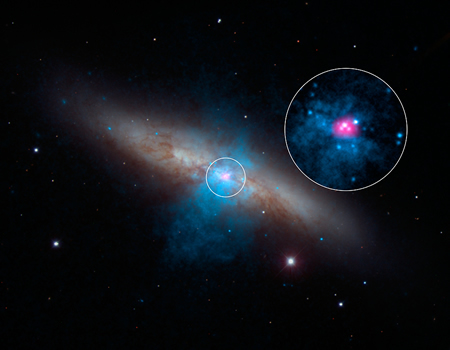
High-energy X-rays streaming from a rare and mighty pulsar (magenta), the brightest found to date, can be seen in this new image combining multi-wavelength data from three telescopes. The bulk of a galaxy called Messier 82 (M82), or the "Cigar galaxy," is seen in visible-light data captured by the National Optical Astronomy Observatory's 2.1-meter telescope at Kitt Peak in Arizona. Starlight is white, and lanes of dust appear brown. Low-energy X-ray data from NASA's Chandra X-ray Observatory are colored blue, and higher-energy X-ray data from NuSTAR are pink. The magenta object is what's known as an ultraluminous X-ray source, or ULX -- a source of blazing X-rays. Previously, all ULXs were suspected to be massive black holes up to a few hundred times the mass of the sun. But NuSTAR spotted a pulsing of X-rays from this ULX (called M82 X-2) - a telltale sign of a pulsar, not a black hole. A pulsar is a type a neutron star -- a stellar core left over from a supernova explosion -- that sends out rotating beams of high-energy radiation. Scientists were surprised to find the pulsar at the root of the ULX because it shines with a luminosity that is more typical of heftier black holes. NuSTAR data covers the X-ray energy range of 10 to 40 kiloelectron volts (keV), and Chandra covers the range .1 to 10 keV. Image credit: NASA/JPL-Caltech/SAO/NOAO
(Edmonton) Astronomers have found a pulsating, dead star beaming with the energy of about 10 million suns. This is the brightest pulsar-a dense stellar remnant left over from a supernova explosion-ever recorded. The discovery was made with NASA's Nuclear Spectroscopic Telescope Array, or NuSTAR.
Pulsars belong to a class of stars called neutron stars. Like black holes, neutron stars are the burnt-out cores of exploded stars, but puny in mass by comparison. Pulsars send out beams of radiation ranging from radio waves to ultra-high-energy gamma rays. As the star spins, these beams intercept Earth like lighthouse beacons, producing a pulsed signal.
The surprising discovery is helping astronomers better understand mysterious sources of blinding X-rays, called ultraluminous X-ray sources (ULXs). They also are suspected to be the long-sought-after "medium-size" black holes-missing links between smaller, stellar-size black holes and the gargantuan ones that dominate the hearts of most galaxies. Until now, all ULXs were thought to be black holes, but new data from NuSTAR show at least one ULX, about 12 million light-years away in the galaxy Messier 82 (M82), is actually a pulsar.
Jeanette Gladstone, formerly a post-doctoral fellow in the University of Alberta's Department of Physics and a world leader in ULX research, was asked by NASA to comment as an external expert on the finding.
"We were starting to settle on the opinion that these [ULXs] were black holes in an extreme state, but this one is smaller and even more extreme than we thought," she says.
"We thought the question was, how massive are these black holes? Are they smaller, stellar remnant black holes eating at extreme rates? Or are they intermediate-mass black holes-the missing link between the smaller sources we see scattered around galaxies and the gargantuan supermassive black holes found in galaxy centres?" Gladstone explains. "Yet here we have a neutron star, much smaller in mass, but on a massive black hole's diet. It's competition eating to the extreme."
Looking at the bigger picture, Gladstone believes this discovery could significantly change our understanding about the rapid growth of black holes in the early universe, shedding light on critical topics including galaxy formation and the evolution of the universe.
Gladstone has recently taken a public outreach role for the U of A observatory that hosts more than 4,000 community visitors and school groups each year. In her new role, she will be working to provide outreach programming to school groups and the public, including the ongoing Thursday viewings at lunchtime and in the evenings.
"We want to give you a chance to see the wonders of astronomy, to explore the night sky and chat with an astronomer. So come along and enjoy the fun."